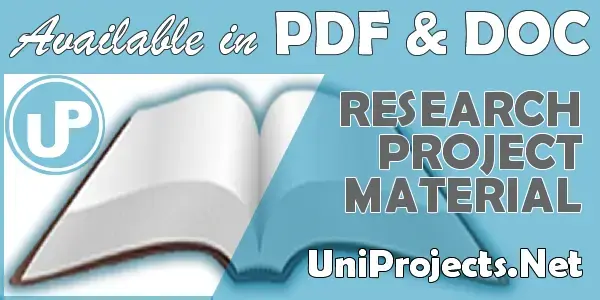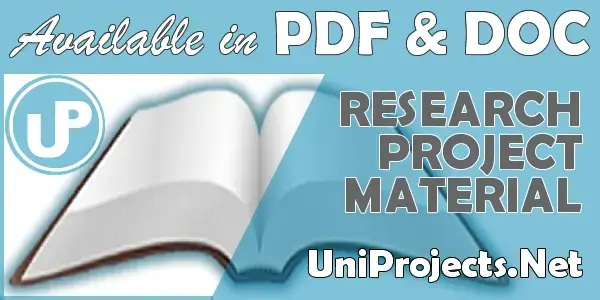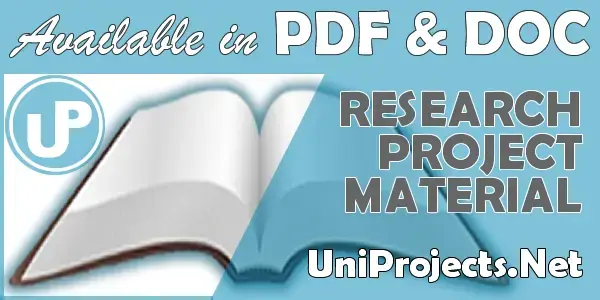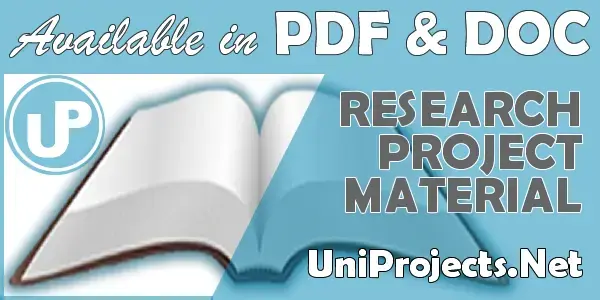Production Of Wood Adhesive
Abstract
Adhesive is a substance that holds materials together by surface attachment, while wood adhesive is a substance that is used to hold plywood for furniture works. This substance is essential and has universal applications. Thus the aim of this research work is to produce it using cassava starch as a base binder. Starch is also used in industries to produce ethanol and glucose for textile industries, laundry and paper adhesive industries.
It is of great importance to paper, wood and furniture industries and the need to produce a more stable adhesive locally to minimize cost remains the investigating factor for embarking on this research work.
The method of wood adhesive production used in this work was the questionnaire work was the gelatinization method. In the production, the optimum gelatinization temperature was found to be 800c while the optimum temperature of dextrin formation is 1400c. The production involves the souring of the starch from cassava, determination of the various additives employed in the production. The materials used in the production works were sourced in line with the objectives of the research. The following components were used: starch extracted from cassava which is responsible for the adhesion force that holds two bodies together, calcium carbonate (CaCo3) for viscosity improvement, formaldehyde as preservative, natrosol cellulose as a thicker and water as solvent.
Experimental analysis was based on all the factors that influence the stability of an adhesive example pH values, viscosity, tack time, boarding strength etc. the values obtained were compared with the standard brands and were found to compare favourable with other standard adhesives.
Formulation B showed the most desirable characteristics and hence is the optimum sample.
An adequate cost analysis was also carried out to determine the feasibility of the project on a commercial venture. Thus, a locally sourced product (wood adhesive) that can complete with similar product in terms of properties but at a much reduced cost was produced. The shelf life and teak time of the product were determined and found to be good. The wood adhesive was established to be water resistant.
Chapter One
INTRODUCTION
1.5 HISTORICAL BACKGROUND (PREAMBLE)
Technology has played an important role in man’s development and thus, has helped to shape the world as it is seen today. This could be seen in all facets of industrial ventures, hence the introduction of new products into the market.
Man’s growing desire to hold two or more substance together by surface attachment so that they can be used a s a single piece coupled with the technological advancement has given birth to a broad range of adhesive production to serve this purpose.
The technique of adhesive bonding has come of age. It is not possible to say when the practice was first developed and used. From history, history made us to believe that the first adhesive even made or used by man was probably clay, animal glue and resinous exudates from trees, of which is known to go back a very long way over 3300 years ago.
The Egyptians used vegetable glue adhesives in wood works and in the production of Papyri. It was during the 19th century that there was technological advancement which led to the sourcing and production of varieties of adhesive. In 1912, F.G Perkins found out that starch could be converted by mild caustic soda solution into liquid glue that was stable at room temperature.
Most of the popular adhesive currently in use in the country is imported as such the clamour for adhesive that are locally produced has been on primary concern for embarking on this project. It is the aim of this project to produce wood adhesive from local raw materials using maize or corn or cassava as the case study or reference study. Though starch can be extracted from plants for example corn, barley, wheat and potatoes and cassava but for simplicity sake have to be reduced to maize and cassava.
1.6 MEANING OF ADHESIVE
There is no universally accepted definition of adhesive, however an adhesive is defined by its usage. It could be defined a substance capable of holding materials together by surface attachment.
The need to hold two or more substances together by surface attachment so that they can be used as a single piece without damage done to the adherents and with more uniform distribution of stress calls for the production of adhesive. Adhesive development has evolved into a field practically on its own, where the market for more specialized adhesives has emerged.
They are now used for a variety of purposes ranging from packaging materials, book binding, and hold wood together, brake lining, where they would have reduced surface to surface contact required. The reasons for joining these surfaces are the get a composite is to affect every handling and create a better outlook.
The working properties of the different adhesives vary therefore various methods were used to obtain an adhesive to serve a defined purpose.
1.7 AIMS AND OBJECTIVES
a. Because of the growing need for adhesive in our industries, it is the aim of this project to produce wood adhesive from local raw materials.
b. It seeks to utilize our available resources that are abundant in nature and cheap to secure.
c. It is also aimed at producing wood adhesive for our industries so that we can achieve self and economic reliance by reducing our dependence on imported variety or foreign adhesive.
d. It also helps to create employment for unemployed youths since adhesive industry does not require complex machinery.
1.8 THE SCOPE OF THE PROJECT
The research work involves the extraction from a locally sourced material for simplicity sake, adhesive formulation under different production condition, to determine the effects of varying production composition on the production. The project would also involve the analysis of the formulation gotten. It also determines the cost of production per annum of small scale plant.
Comparison between standard (wood adhesive gotten from the market) and that produced from this project. It is done by detailed analyst of the production properties.
Chapter Two: Literature Review
2.0 INTRODUCTION:
This chapter provides the background and context of the research problems, reviews the existing literature on the Production Of Wood Adhesive, and acknowledges the contributions of scholars who have previously conducted similar research [REV23811] …
Table of Content
Title page
Letter of transmittal
Approval page
Dedication
Acknowledgement
Abstract
Table of Contents
CHAPTER ONE
INTRODUCTION
1.1 Historical background (preamble)
1.2 Meaning of adhesive
1.3 Aims and objectives
1.4 The scope of the project
CHAPTER TWO
LITERATURE REVIEW (SURVEY)
2.1 Historical report on adhesives.
2.2 Starch adhesive.
2.3 Adhesives
2.4 Classification of adhesive.
2.5 Factors considered when selecting a wood adhesive.
2.6 Advantages and limitations of the adhesives with respect to mechanical fasteners.
2.7 Adhesion and cohesion.
2.8 Components of adhesives
2.9 Starch.
2.10 Physical properties of starch
2.11 Chemical properties of starch
2.12 Degr isolation of starch
2.13 Adation of starch
2.14 Gelatinisation of starch.
2.15 Cassava Starch
2.16 Maize Starch
2.18 Components Of Starch Adhesives And Their Functions
CHAPTER THREE
MATERIALS AND DMETHOD FOF ANALYSIS.
3.1 Source of materials
3.2 This research work involves.
3.2.1 Extraction of starch from cassava.
3.2.2 Production of wood adhesive from cassava starch.
3.2.2.1 Procedure
3.2.3 Analysis
3.2.3.1 Bonding Strength Determination
3.2.3.2 Melting Point Determination
3.2.3.3 Spreadability Test
3.2.3.4 Solid content determination
3.2.3.5 Ph determination
3.2.3.6 Moisture content determination
3.2.3.7 Resistance to moiture.
3.2.3.8 Shelf life test.
3.2.3.9 Viscosity test
3.2.3.1 Tack time determination
3.2 Packaging and storage
3.3 Comparing the product with the standard set
CHAPTER FOUR
RESULT AND DISCUSSIONS
4.1 Experimental Results
4.2 Comparative with Standards: Parameters for Ranges of Wood Adhesives.
4.2.0 Discussions
CHAPTER FIVE
CONCLUSION AND RECOMMENDATION
5.1 Conclusion.
5.2 Recommendations
References
Appendix




